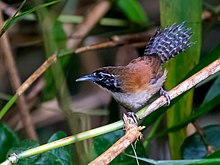| Coraya wren | |
|---|---|

| |
| call recorded in Ecuador | |
| Conservation status | |
 Least Concern (IUCN 3.1) | |
| Scientific classification | |
| Domain: | Eukaryota |
| Kingdom: | Animalia |
| Phylum: | Chordata |
| Class: | Aves |
| Order: | Passeriformes |
| Family: | Troglodytidae |
| Genus: | Pheugopedius |
| Species: | P. coraya |
| Binomial name | |
| Pheugopedius coraya (Gmelin, JF, 1789) | |

| |
| Synonyms | |
|
Thryothorus coraya | |
The coraya wren (Pheugopedius coraya) is a species of bird in the family Troglodytidae, the wrens.
Taxonomy
The coraya wren was formally described in 1789 by the German naturalist Johann Friedrich Gmelin in his revised and expanded edition of Carl Linnaeus's Systema Naturae. He placed it with the thrushes in the genus Turdus and coined the binomial name Turdus coraya. Gmelin based his description on "Le Coraya" from Cayenne in French Guiana that had been described in 1778 by the French polymath the Comte de Buffon in his Histoire Naturelle des Oiseaux. A hand-coloured engraving by François-Nicolas Martinet was published to accompany Buffon's text. The word "coraya" as the specific epithet and in the common name is a homophone for the French queue rayée meaning "barred tail". The coraya wren is now one of twelve placed in the genus Pheugopedius that was introduced in 1851 by the German ornithologist Jean Cabanis.
Ten subspecies are recognised:
- P. c. obscurus (Zimmer, JT & Phelps, WH, 1947) – east Venezuela
- P. c. caurensis (Berlepsch & Hartert, EJO, 1902) – east Colombia, south Venezuela and northwest Brazil
- P. c. barrowcloughianus (Aveledo & Peréz, 1994) – southeast Venezuela
- P. c. ridgwayi (Berlepsch, 1889) – northeast, east Venezuela and west Guyana
- P. c. coraya (Gmelin, JF, 1789) – the Guianas and north Brazil
- P. c. herberti (Ridgway, 1888) – northeast Brazil south of the Amazon
- P. c. griseipectus (Sharpe, 1882) – east Ecuador, northeast Peru and west Brazil
- P. c. amazonicus (Sharpe, 1882) – east Peru
- P. c. albiventris (Taczanowski, 1882) – north Peru
- P. c. cantator (Taczanowski, 1874) – central Peru
Distribution and habitat
It is found in Amazonian northern and northwestern South America, the northern Amazon Basin and the Guianas, of Guyana, French Guiana, Suriname, and Amazonian southeast Colombia, eastern Ecuador, and north and central Peru; also the southeastern Orinoco River Basin of Venezuela. Its natural habitats are subtropical or tropical moist lowland forests, subtropical or tropical swamps, and heavily degraded former forest.
Besides the northern Amazon Basin and the Guianas including the Guiana Highlands, the contiguous range in the southeastern Amazon Basin extends to Maranhão state Brazil, and covers the downstream third of the three north-flowing river systems: the Tapajós River, Xingu River, and the Araguaia-Tocantins River system; in the Andean west, in central Peru, the range extends southward, upstream 1300 km into the Ucayali River drainage region of central Peru.
The two non-Amazon Basin areas are the Caribbean Orinoco River of Venezuela, (in the southeast), and the north-flowing Atlantic areas of the Guianas. The coraya wren can be found on Ilha de Marajo at the Amazon River's outlet.
Description
It is a medium-sized wren, rufous-(chestnut)-brown overall with a medium length black-and-white banded tail. It has a buff white breast, white throat and an overall black head, flecked with white feathers; notably a narrow upper bright white eye stripe, and a narrow white eye ring of white feathers. It has a medium length black decurved bill, black eyes, and gray-black legs. It is darker brown on its back, deep brown-blackish wings, and lighter buff brown on its sides.

References
- BirdLife International (2018). "Pheugopedius coraya". IUCN Red List of Threatened Species. 2018: e.T22711416A132097568. doi:10.2305/IUCN.UK.2018-2.RLTS.T22711416A132097568.en. Retrieved 16 November 2021.
- Gmelin, Johann Friedrich (1789). Systema naturae per regna tria naturae : secundum classes, ordines, genera, species, cum characteribus, differentiis, synonymis, locis (in Latin). Vol. 1, Part 2 (13th ed.). Lipsiae : Georg. Emanuel. Beer. p. 825.
- Mayr, Ernst; Greenway, James C. Jr, eds. (1960). Check-list of Birds of the World. Vol. 9. Cambridge, Massachusetts: Museum of Comparative Zoology. p. 403.
- Buffon, Georges-Louis Leclerc de (1778). "Le Coyaya". Histoire Naturelle des Oiseaux (in French). Vol. 4. Paris: De l'Imprimerie Royale. pp. 484–485.
- Buffon, Georges-Louis Leclerc de; Martinet, François-Nicolas; Daubenton, Edme-Louis; Daubenton, Louis-Jean-Marie (1765–1783). "Le Coraya, de Cayenne". Planches Enluminées D'Histoire Naturelle. Vol. 8. Paris: De L'Imprimerie Royale. Plate 701, Fig. 1.
- Jobling, James A. (2010). The Helm Dictionary of Scientific Bird Names. London: Christopher Helm. p. 118. ISBN 978-1-4081-2501-4.
- ^ Gill, Frank; Donsker, David; Rasmussen, Pamela, eds. (July 2023). "Dapple-throats, sugarbirds, fairy-bluebirds, kinglets, hyliotas, wrens & gnatcatchers". IOC World Bird List Version 13.2. International Ornithologists' Union. Retrieved 12 August 2023.
- BirdLife International 2004. Thryothorus coraya. 2006 IUCN Red List of Threatened Species. Downloaded on 27 July 2007.
External links
- Coraya Wren videos on the Internet Bird Collection
- Coraya Wren photo gallery VIREO Photo-High Res
- Photo-High Res; Article oiseaux
| Taxon identifiers | |
|---|---|
| Pheugopedius coraya |
|
| Turdus coraya | |
This Troglodytidae-related article is a stub. You can help Misplaced Pages by expanding it. |
- IUCN Red List least concern species
- Pheugopedius
- Birds of the Amazon rainforest
- Birds of the Guiana Shield
- Birds of the Colombian Amazon
- Birds of the Venezuelan Amazon
- Birds of the Ecuadorian Amazon
- Birds of Peruvian Amazonia
- Birds described in 1789
- Taxa named by Johann Friedrich Gmelin
- Birds of Brazil
- Troglodytidae stubs